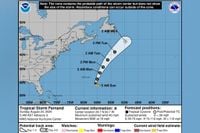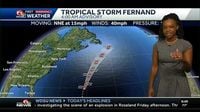Tropical Storm Fernand, the sixth named storm of the 2025 Atlantic hurricane season, formed over the open Atlantic Ocean southeast of Bermuda on Saturday, August 23, 2025, and quickly drew the attention of meteorologists and coastal residents alike. With memories still fresh from the recent Hurricane Erin—whose powerful waves battered the East Coast but never made landfall—many wondered if Fernand would chart a similar course or pose a new threat to land.
According to the National Hurricane Center (NHC), Fernand was first identified about 400 miles south-southeast of Bermuda. By Sunday morning, August 24, the storm had advanced to a position approximately 300 miles southeast of the island. At that time, Fernand’s maximum sustained winds hovered at 40 miles per hour, with occasional higher gusts—a threshold that marks the minimum for a system to be classified as a tropical storm. The NHC noted that Fernand was moving north-northeast at a brisk 15 mph, a trajectory expected to continue for the next couple of days before a gradual turn to the northeast.
Forecasters from Fox Weather and CBS News agreed that Fernand’s path would keep it well east of Bermuda and far from the U.S. coastline. In its official advisory, the NHC stated, “On the forecast track, Fernand should move well east of Bermuda and across the open waters of the subtropical North Atlantic.” The storm was predicted to strengthen over the weekend, with some models suggesting it could briefly approach hurricane strength by Monday, August 25. However, the outlook beyond that point was less dramatic: “After Monday, Fernand should weaken due to the influences of cooler waters and increasing shear, and the storm will likely become post-tropical in 3-4 days,” NHC forecasters said, as reported by Fox Weather.
Despite Fernand’s remote location, its presence was not entirely benign. The NHC warned that dangerous surf and gale conditions were expected around Bermuda during the early part of the workweek, as the storm made its closest approach. Residents and visitors on the island were urged to stay vigilant and monitor updates, as even a slight westward deviation could lead to more significant impacts.
Fernand’s formation came on the heels of Hurricane Erin, the first hurricane of the season, which reached a ferocious Category 5 at its peak. Although Erin never made landfall, it unleashed powerful winds, dangerous rip currents, and flooding along parts of the East Coast. According to CBS News, “Erin didn’t make landfall, but at its peak it grew to a ferocious Category 5, and it caused strong winds, dangerous rip currents and flooding along parts of the East Coast.” The pattern of storms forming in the open Atlantic and skirting populated areas has been a source of both relief and anxiety for coastal communities.
For the United States, the weather patterns have been particularly favorable this August. An extensive trough stretching across the eastern half of the country has acted as a “hurricane barrier,” according to Fox Weather, keeping tropical threats at bay through the end of the month. This same trough has brought a taste of fall to more than 100 million Americans east of the Rockies, with temperatures dipping 10 to 30 degrees below average—a welcome respite from the usual summer heat and hurricane anxiety.
While Fernand dominated the headlines, meteorologists were also keeping a close eye on another system: Invest 99L. This tropical disturbance, situated less than 1,000 miles east of the Caribbean islands, was being monitored for potential development. As of August 24, Invest 99L was about 450 miles east of the Windward Islands, moving quickly westward at 20 to 25 mph. The NHC noted, “This system could become a tropical depression during the next day or two while it moves quickly westward at about 20 to 25 mph, passing through the Windward and Leeward Islands late today or tonight.” Regardless of its development, Invest 99L was expected to bring locally heavy rain and strong winds to portions of the islands on Sunday and Monday, before encountering less favorable conditions in the central Caribbean by Tuesday, August 26.
Hurricane Hunters were on standby to fly into Invest 99L if necessary, a testament to the vigilance of the agencies tracking these storms. The NHC gave the disturbance a 40 percent chance of cyclone development over both 48 hours and seven days, but forecast models suggested that any significant intensification would likely be short-lived.
The 2025 Atlantic hurricane season, which runs through November 30 and typically peaks in September, has already lived up to forecasts of above-normal activity. The National Oceanic and Atmospheric Administration (NOAA) has predicted between 13 and 18 named storms this year, with five to nine expected to become hurricanes. Fernand is the sixth named storm of the season, following Erin, and the next storm to form will be named Gabrielle.
As meteorologist Phil Ferro observed on X (formerly Twitter), “Saturday Tropical Storm Fernand Advisory & Cone: No change in strength from the previous advisory, but could get better organized by Monday. The Forecast Cone shows it will stay far from land and eventually reach cooler waters by midweek. Should weaken by then.” Similarly, meteorologist Eric Zernich commented, “Tropical Storm Fernand formed Saturday afternoon but it remains a very weak storm with winds up to 40 mph. Fernand could slowly strengthen over the coming days, but should stay way out to sea and away from the East Coast.” The NHC itself posted, “Fernand Continuing North-Northeastward Over the Open Atlantic.”
For those tracking the storm’s progress, spaghetti models—those colorful, sometimes perplexing lines that represent potential paths—have been in rare agreement that Fernand will remain a maritime event. While the risk to land remains low, the storm serves as a reminder that the Atlantic remains active, and that vigilance is required as the season enters its peak.
Meanwhile, the formation of Fernand and the monitoring of Invest 99L highlight the importance of preparedness and the value of regular updates from trusted sources like the NHC. As the hurricane season continues, the eyes of meteorologists, emergency managers, and coastal residents remain fixed on the Atlantic, watching for any sign that the next storm might take a more menacing turn.
For now, Fernand’s journey across the open ocean offers a reprieve for those on land, even as it stirs up the seas and keeps forecasters busy. The Atlantic’s story this season is far from over, but with each advisory and update, coastal communities can better prepare for whatever comes next.






